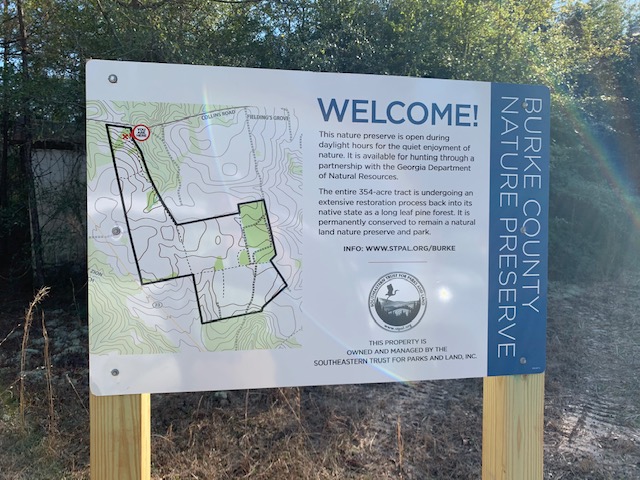Burke County Nature Preserve
Undergoing environmental enhancement and restoration

Longleaf Pine forest restoration project
Conservation
2023 Update: Another 100,000 longleaf pine seedlings were planted at Burke County Nature Preserve in February 2023!
Each March in 2019, 2020, and 2021, +/- 60 acres were hand planted with longleaf pine seedlings at a rate of 600 seedings per acre. Once the seedlings emerge from the bush stage (3-5 years) appropriate native ground cover will be established. The general plan going forward is to plant two additional +/- 50-acre sections in longleaf pine with a gap year between each planting. The longleaf seedlings are planted at a density that should yield a sustainable natural density. There is a failure rate for the seedlings of 10-35% which should create randomness to the forest’s density. Native appropriate plants will be added to the open spaces. There are no plans to ever do any commercial harvesting of the longleaf pines. The areas not planted with longleaf pines will be transitioned into other typical native habitats with areas such as mixed pine & hardwood stands, grasslands, and transition areas. The goal is to return the tract to its presumed native state. It may take 75-100 years to achieve, but it should be worth the wait.
As the site develops, it will be improved as a habitat for wildlife such as white-tailed deer, raccoon, opossum, parula warbler, gray squirrel, hooded warbler, tufted titmice, northern bobwhite, cardinal, nuthatch, blue jays, field sparrow, yellow-breasted chat, several woodpecker species, northern mockingbird, green frog, southern toad, bobcat, gray fox, fox squirrel, wood rat, vole, and shrew. A variety of native reptiles and amphibians are likely to include various non-venomous water snakes, black rat snakes, copperhead snakes, canebrake rattlesnakes, green tree frogs, fence lizards, and green anoles.
Rare and endangered plant species could likely include Caroline pink, Georgia aster, sandhill rosemary, hooded pitcher plant, pink lady slipper, and sandhill milkvetch. Rare and endangered wildlife could likely include Bachmann’s sparrow, Southeastern pocket gopher, painted bunting, and southern hog-nose snake. There should be neotropical migrants like the gray catbird, yellow-breasted chat, field sparrow, loggerhead shrike, and prairie warbler.
To date, STPAL has about $90,000 invested in the restoration process of this property.
Recreation
None at this time.
Community
None at this time.